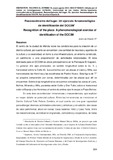Reconocimiento del lugar. Un ejercicio fenomenológico de identificación del DCC3M.

View/
Date
2022-05-03Author
Palabras Clave
Distrito cultural y creativo, Cultura, Arte, Ciudad, MéridaCultural and creative district, Culture, Art, City, Mérida
Metadata
Show full item recordAbstract
El centro de la ciudad de Mérida reúne las condiciones para la creación de un distrito cultural,
por cuanto se concentran una cantidad de recursos y agentes de la cultura y la creatividad, en
torno a una infraestructura, un entorno construido, un patrimonio y una programación de
actividades relacionadas. El área delineada para el DCC3M se ubica principalmente en la Parroquia
El Sagrario. Lo generan dos ejes principales, en sentido longitudinal sobre la Av. 3, y
transversal sobre la Calle 22. Sus extremos son las plazas el Llano y Milla, sus transversales
las Heroínas y las escalinatas de Pueblo Nuevo. Esta figura de “T” se propone comprender por
zonas, determinadas por las plazas que allí se encuentran. Sobre el eje longitudinal se
encuentran alineadas las zonas el Llano, Bolívar, Miranda y Milla, paralelas están Colón y Don
Tulio; sobre el transversal están el Espejo y las Heroínas; el centro de ambos ejes lo ocupa la
Plaza Bolívar. En esta área se evidencian inmanencias y trascendencias, que explican en mayor
detalle su potencial cultural. Entre las inmanencias se mencionan el Centro Cultural Tulio Febres
Cordero, el cual cuenta con una gran capacidad para albergar diversas actividades culturales y
artísticas; y en adición, dos casas de valor patrimonial, ahora en ruinas: Casa Galerías 1890 y
Casa Parra. Entre las trascendencias, se indican el engranado, competitivo y cooperativo, de
todas las actividades culturales y creativas; y, la cultura pensada como aparato productivo y
catalizador, generador de riqueza y bienestar para el sector. Para lograr esto se propone un hub
inter-conector entre todos los recursos y agentes, que integre y promueva el DCC3M como
herramienta de revitalización y desarrollo.
Collections
Información Adicional
| Otros Títulos | Recognition of the place. A phenomenological exercise of identification of the DCC3M. |
| Correo Electrónico | - |
| Editor | SaberULA |
| ISSN | 0798-3069 |
| Resumen en otro Idioma | Mérida’s city center has the right conditions for the creation of a cultural district; there is a significant concentration of resources and agents related to culture and creativity in and around an infrastructure, a built context, a heritage and a program of related activities.The area for the DCC3M is limited mainly to El Sagrario sector. It is defined by two axes, the long one over Av. 3 and the short over Calle 22. The two extreme poles are the squares el Llano and Milla, and Heroínas and the entrance to Pueblo Nuevo respectfully. This urban form in “T” is to be understood by zones, which are represented by their local squares. Along the long axis these areas are Llano, Bolívar, Miranda and Milla; in parallel Colón and Don Tulio. Over the short axis are Espejo and Heroínas, while the centre of both axes is occupied by Plaza Bolívar. In the whole area there are immanent and transcendent elements, which explain the cultural potential. Among the immanent ones, we have the Cultural Center Tulio Febres Cordero, which has a great capacity for many cultural and artistic activities. And two houses of heritage value, Casa Galerías 1890 and Casa Parra, which are unfortunately in ruins. On the other hand, the transcendent ones correspond to the competitive and cooperative network of all cultural and creative activities; and the conception of culture as production and catalyzer of richness and wellness for the area. To achieve this, the proposal is a hub to interconnect all the resources and agents, and thus promote the DCC3M as a tool of revitalization and development. |
| Colación | 304-326 |
| Periodicidad | Cuatrimestral |
| País | Venezuela |
| Institución | Universidad de Los Andes |
| Sección | Fermentum: Artículos |





